COSTA BLANCA
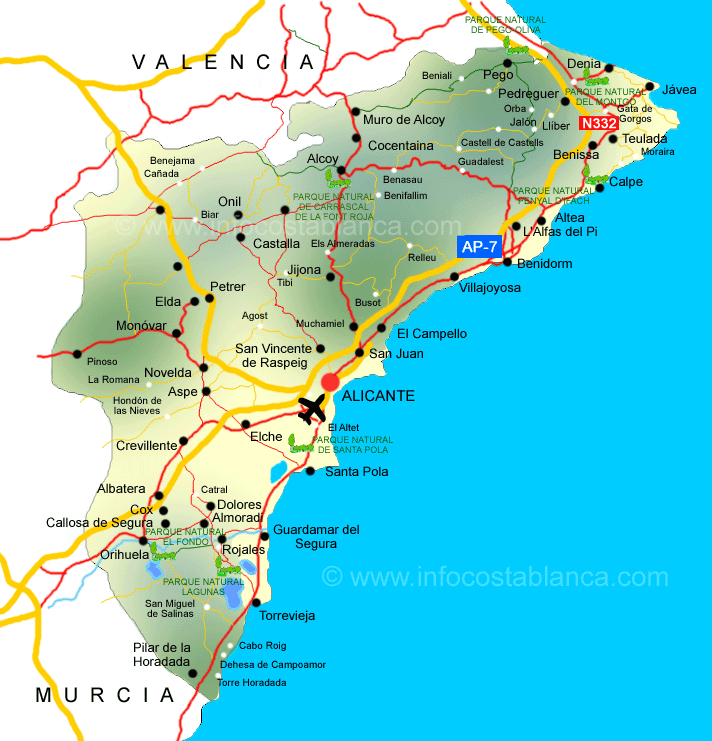
Costa Blanca, joka tarkoittaa ”valkoista rannikkoa”, on Alicanten provinssissa, Valencian maakunnassa sijaitseva alue, jonka rantaviiva on yli 200 kilometriä. Aluetta pidetään juuri suolajärvien runsauden vuoksi yhtenä Euroopan terveellisimmistä alueista. Suolajärvien läheinen mikroilmasto auttaa erinomaisesti kaikenlaisiin nivelvaivoihin, selkäkipuun, ihosairauksiin ja esimerkiksi ylähengitysteiden sairauksiin. Yllättävästi esimerkiksi astma tai selkävaivat voidaan katsoa selätetyiksi Costa Blancalla.
Costa Blancan alueen rannat ovat Espanjan parhaita ja monet niistä ovat ansainneet myös ”Blue Flag” -statuksen (https://www.blueflag.global/). Sieltä löytyy sekä rantoja lumivalkoisine hiekkoineen ja palmuineen että kalliorantoja, joissa on erivärisiä kaloja ja kristallinkirkas vesi. Rannat ovat hyvässä kunnossa ja niille pääsee helposti.
Alueelle on ominaista myös torien runsaus. Jokaisessa pienessä kaupungissa on perinteisesti toripäivä, josta löytyy runsaasti tuoreita mereneläviä, hedelmiä ja vihanneksia (makeimmat appelsiinit), paikallisia käsitöitä, vaatteita jne.
Vaikkakaan Costa Blanca ei ole pinta-alaltaan suurin alue, maasto on erittäin vaihtelevaa – pohjoisrannikkoa luonnehtivat kalliot, vuoret ja vehreys, kun taas etelärannikko on hieman lämpimämpi, kuivempi ja tasaisempi.
Costa Blancan ilmasto on yleensä vakaa ympäri vuoden. Talvet ovat hieman kesiä viileämpiä, mutta myös talvilämpötilat ovat verrattavissa Viron kesään.
Dénia ja Javea
Dénia on pieni viihtyisä kaupunki Costa Blancan pohjoisosassa. Kauniiden rantojen lisäksi Denialla on myös historiallista ja kulttuurista arvoa. Denia on sekoitus iberialaista, roomalaista, islamilaista ja kristillistä kulttuuria, jotka kaikki ovat jättäneet jälkensä kaupunkiin. Denia on rakennettu keskustan vuoristolinnan ympärille. Linnasta avautuvat upeat näkymät kaupunkiin, satamaan ja merelle sekä Montgo-vuorelle, jonka reunalle Denia on rakennettu. Linna on rakennettu 1000-luvulla ja siellä sijaitsee myös paikallinen kaupunginmuseo.
Denian rantaviiva on 15 kilometriä pitkä. Sinne mahtuu niin hiekkarantoja kuin kallioiden ympäröimiä pieniä erillisiä lahtia, joiden vesi on kristallinkirkasta. Veden ystäville löytyy runsaasti harrastusmahdollisuuksia – sukeltaminen, snorklaus, veneiden vuokraus, katamaraaniretket, delfiinien bongaus, suppailu, surffaus jne.
Koska Denia on mantereella Baleaarin saaria lähin kaupunki, sillä on hyvä lauttayhteys saarten kanssa. Miksi et viettäisi yhtä päivää Ibizaan tutustuen?
Deniaan saavuttaessa ei luonnollisestikaan voi olla näkemättä 753 metrin korkuista Montgo-vuorta, joka erottaa Denian ja Javean. Montgon luonnonsuojelualue on monien erityisten kasvi- ja lintulajien koti. Montgo-vuorelle pääsee helposti ja se tarjoaa elämyksen sekä patikoinnin että pyöräilyn harrastajille.
Javea sijaitsee Montgo-vuoren eteläpuolella. Se on pieni ja maalauksellinen rannikkokaupunki, joka perustettiin jo 30 000 vuotta sitten. Javeaa luonnehtii sen historiallinen vanhakaupunki, pienet kirkasvetiset rannat ja vesiurheilu sekä ympärivuotiset festivaalit.
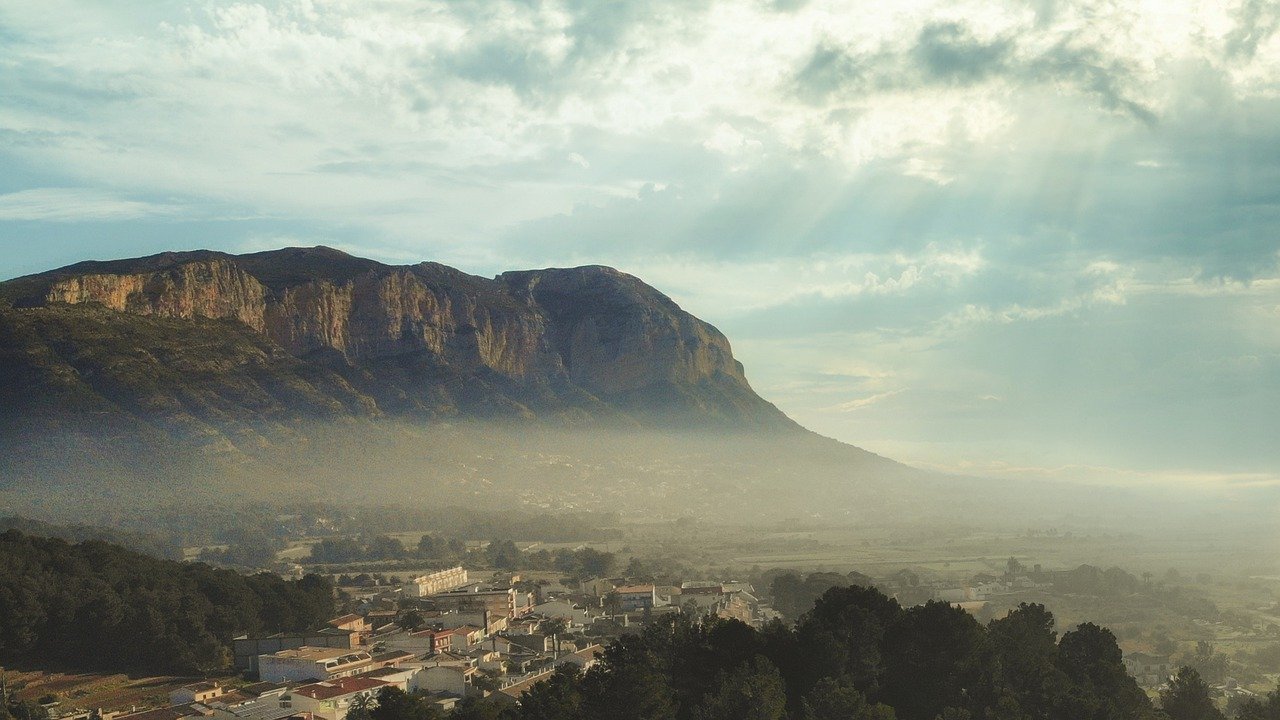
Calpe
Calpe tunnetaan massiivisesta 332-metrisestä, mereen ulottuvasta kapeasta kallionkielekkeestä. Kallio näkyy jo kaukaiselta moottoritieltä ja erottuu selvästi poikkeavan muotonsa ansiosta. Kallionlohkare tarjoaa elämyksen sekä alhaalta ylös että ylhäältä alas katsottaessa. Lohkareen ympärillä sijaitsee Penyal d'Ifacin luonnonpuisto, josta löytyy monia harvinaisia kasvi- ja lintulajeja. Lohkareen lisäksi Calpessa on runsaasti tekemistä ja näkemistä. Nähtävyyksiin kuuluvat myös esimerkiksi ”Los Baños de la Reina” eli kuningattaren altaat, suolakentät sekä tietenkin kaunis vanhakaupunki ja kävelykatu.

Benidorm
Benidorm, jota voitaisiin kutsua myös paikalliseksi Manhattaniksi, on suosittu matkailukohde Altean ja Alicanten välissä. Benidorm alkoi kasvaa ja saada suosiota vasta 1950-luvulla, kun turistit pääasiassa Espanjan sisämaasta ja erityisesti Madridista ryhtyivät lomailemaan ja rakentamaan kesäkoteja Benidormiin. Nykyään Benidorm erottuu kaukaa runsailla pilvenpiirtäjillään, joita ei löydy esimerkiksi lähimmästä suurkaupungista, Alicantesta.
Benidorm on erittäin suosittu brittien, irlantilaisten, belgialaisten ja saksalaisten keskuudessa erityisesti kyseisistä maista tehtävien edullisten pakettimatkojen ansiosta. Kaupungista löytyy myös suuri huvipuisto, vesipuisto ja teemapuisto. Benidorm tunnetaan myös loputtomasta yöelämästään, joka ei vaikene edes viileämpinä talvikuukausina.
Benidormista sisämaahan ajettaessa matkan varrella on monia kauniita paikkoja – mm. Guadalestin linna ja kylä, Algarin vesiputoukset, dinosauruspuisto jne. Jos et halua asua pilvenpiirtäjässä tai suurkaupungin metelissä, muttet myöskään halua olla liian kaukana siitä, Benidormin vieressä vuoren rinteellä sijaitseva Polop on erinomainen valinta.
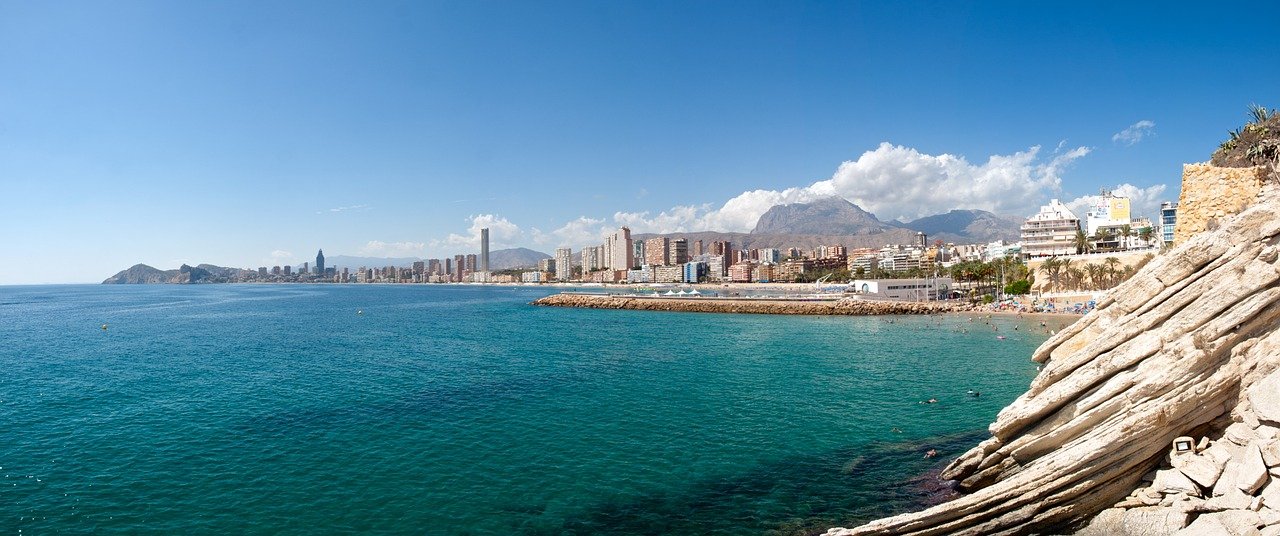
Alicante
Alicante on provinssin ja Costa Blancan suurin kaupunki ja keskus sekä Valencian maakunnan toiseksi suurin kaupunki. Alicante ei ole vain lomakaupunki, vaan myös tärkeä talouskeskus. Alicantessa on monta yliopistoa, suuri satama, Euroopan unionin immateriaalioikeuden osasto sekä useita tehtaita. Aiemmin siellä sijaitsi myös esimerkiksi Euroopan suurin filmistudio, joka on valitettavasti nykyisin suljettu.
Alicantella on rikas historia ja kaupungin keskuksena voidaan pitää jo kilometrien päästä näkyvää, 800-luvulta peräisin olevaa Santa Barbaran linnoitusta. Kaupungissa on monia muitakin historiallisia, mutta myös paljon nykyaikaisia rakennuksia.
Santa Pola
Santa Pola on melko laajalle ulottuva alue Alicanten ja Torreviejan välissä rannikolla. Santa Pola sijaitsee strategisesti erinomaisessa paikassa. Lentokenttä on vain noin 10–15 minuutin ajomatkan päässä ja Alicanten keskusta on alle 20 kilometrin päässä. Santa Polan rannikkoa luonnehtivat niin hiekkadyynit, mäntymetsä kuin myös kalliot. Santa Polan ympäristö näyttää kartalta katsottuna tilkkutäkiltä läheisyydessä sijaitsevien useiden suolajärvien ja kaivosten ansiosta. Suolajärvet ovat mieluisa pesimispaikka eksoottisille flamingoille. Santa Polasta on kätevä matkustaa lautalla tai katamaraanilla lähellä sijaitsevalle pienelle Tabarcan saarelle, joka
tunnetaan värikkäistä kaloistaan, kristallinkirkkaasta
vedestään ja snorklausmahdollisuuksistaan.
Torrevieja
Torrevieja on yksi Valkoisen rannikon tunnetuimmista lomanviettokaupungeista. Kyseessä on kaupunki, jossa on tekemistä ympäri vuoden, ja se on erittäin suosittu kohde kaikkien kansallisuuksien keskuudessa. Torreviejassa asuu ympärivuotisesti noin 100 000 ihmistä, mutta kesäisin asukasluku nelinkertaistuu. Ainoastaan puolet tästä ovat espanjalaisia. Sekä vakioasukkaiden että lomailijoiden joukosta löytyy paljon brittejä, hollantilaisia, saksalaisia, norjalaisia, ruotsalaisia, venäläisiä, ranskalaisia jne. Torrevieja sijaitsee maantieteellisesti erinomaisella paikalla ja sitä pidetään yhtenä Espanjan terveellisimmistä alueista, sillä sitä ympäröi toiselta puolelta Välimeri ja toiselta puolelta kaksi suolajärveä, jotka luovat kaupunkiin erityisen mikroilmaston. Mikroilmasto sopii hyvin ihmisille, jotka kärsivät esimerkiksi astmasta tai selkä- ja nivelkivuista. Myös Torreviejan sairaala on huipputasoa ja kansainvälisesti arvostettu.
Kaupungista löytyy tekemistä sekä nuorille että vanhoille – kaupungissa on museoita, huvipuisto, vesipuisto, elokuvateattereita, ostoskeskuksia, rantoja, kouluja jne.
Torreviejan kiinteistöhinnat ovat edullisempia kuin hieman pohjoisemmissa lomanviettokaupungeissa. Toisaalta hintataso kaupungin eri alueilla on hyvin erilainen, asunnon voi ostaa niin 30 000 eurolla kuin myös 130 000 eurolla.
Torrevieja on varma valinta sekä niille, jotka haluavat tulla Espanjaan asumaan, että niille, jotka haluavat vain lomailla.
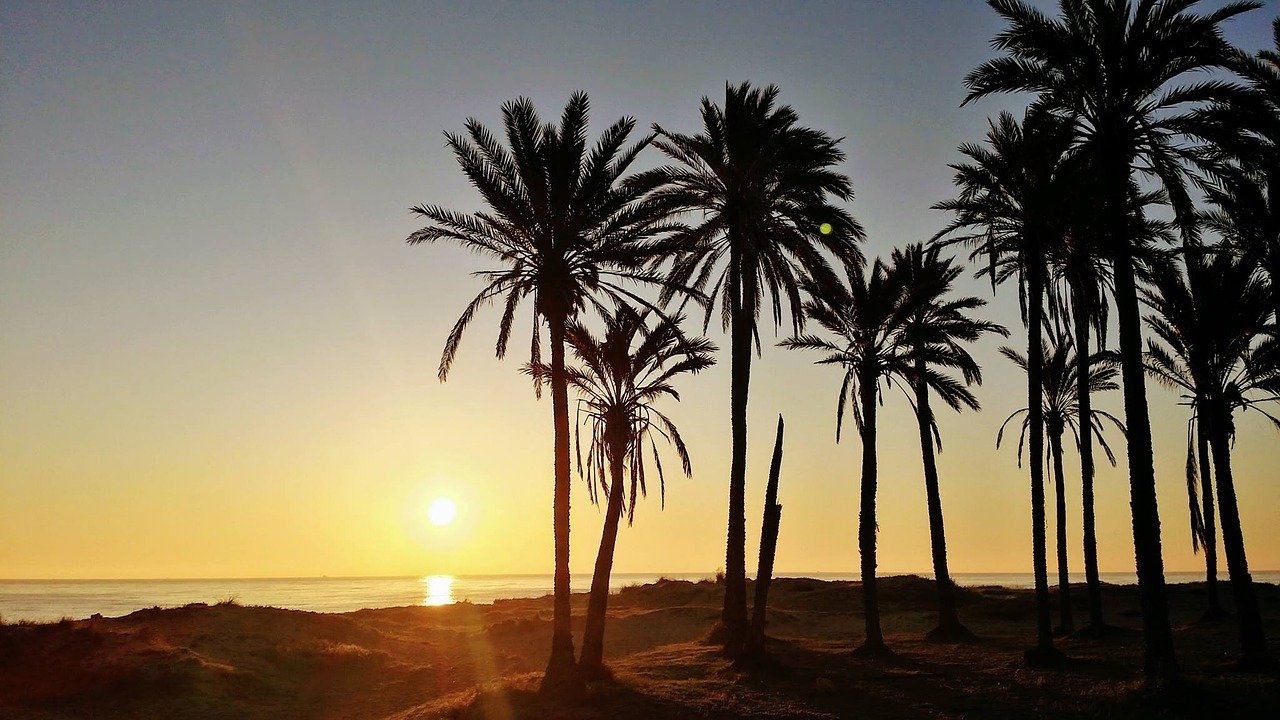
Orihuela Costa
Orihuela Costa, joka tarkoittaa Oriehulan rannikkoa, on todellisuudessa suuremman provinssin, Orihuealan, ns. esikaupunki. Orihuela Costa yhdistää La Zenian, Cabo Roigin, Dehese de Campoamorin, San Miguel de Salinastin, Villamartinin, Pilar de Campoverden, Los Dolsesin, La Fuenten ja Los Montesinosin, eli kyseessä on melko suuri alue. Alue on erittäin suosittu juuri englantilaisten keskuudessa, joten esimerkiksi tietyt kadut muistuttavat pientä Englantia.
Orihuela Costan rantaviiva on hyvin omaperäinen. Siellä vaihtelevat selkeät valkohiekkaiset rannat, pienet kallioiden ympäröimät hiekkaiset sopukat sekä korkeat kalliot, josta portaat vievät alas kiviseen rantaan. Erityisen kaunis on esimerkiksi Punta Prima, joka herättää huomiota runsaspalmuisilla kaduillaan ja huipputasoisilla uudisrakennuskokonaisuuksillaan, joista eivät puutu myöskään esimerkiksi kylpylät ja kuntosalit.
Golfaajille Orihuela Costa on paratiisi – monet Costa Blancan suosituimmista golfkentistä sijaitsevat juuri siellä. Orihuela Costan kiinteistöjen hinnat ovat erittäin kohtuullisia. Jos tunnet olosi varmemmaksi omanmaalaisten seurassa, Orihuela Costalla asuu useita virolaisia perheitä.
COSTA CALIDA
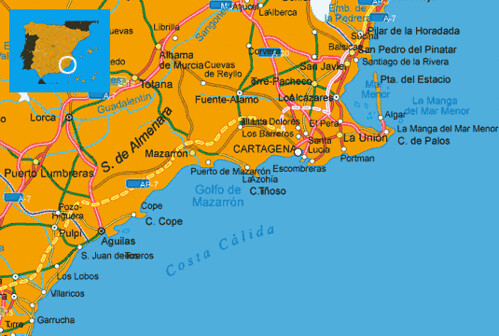
Costa Calidaksi eli kuumaksi rannikoksi kutsutaan n. 250 kilometrin rantaviivaa Murcian maakunnassa. Maakunta on nimetty suhteellisen korkean vuotuisen keskilämpötilan ja alhaisen sademäärän mukaan. Vaikka myös Costa Blancalla sataa vähän, Costa Calidassa on erityisen paljon aavikoita ja kuivia alueita.
Costa Calidan tärkeimmät kaupungit ovat Cartagena ja Mazarron. Costa Calida on turistien keskuudessa hieman vähemmän suosittu kuin Costa Blanca, mutta omaperäisen maastonsa, lahdensopukoittensa, viheralueidensa, aavikoidensa ja vuoristonsa vuoksi se ei ole ollenkaan vähäisemmän suosion arvoinen.
Costa Calida on myös kiinteistön ostoon hieman edullisempi alue – sieltä voi löytää hyvällä hinta-laatusuhteella sekä rannalla sijaitsevia uudisrakennuksia että second-hand-kiinteistöjä.
Costa Calidan suurin kaupunki on Cartagena, joka voittaa vanhallakaupungillaan useammankin ns. vanhankaupungin Espanjassa. Cartagena perustettiin jo lähes 2 000 vuotta sitten ja sen loiston aika jäi Rooman valtakuntaan, jolloin sitä kutsuttiin myös uudeksi Karthagoksi. Cartagena on yksi läntisen Välimeren tärkeimmistä puolustussatamista ja se on nykyisinkin Espanjan sotalaivaston kotisatama. Cartagenassa on monia historiallisia nähtävyyksiä, kuten vanha roomalainen teatteri ja yli 700-vuotias Santa Maria La Viejan katedraali.
Costa Calidan suosituimmat lomakeskukset sijaitsevat Mar Menorin lähistöllä. Mar Menor on korkearakennuksinen lomakeskus, joka sijaitsee pitkällä hiekkakaistaleella ja erottaa Välimeren ja Mar Menorin, eli Pienemmän meren. Todellisuudessa erotettu Mar Menor on suuri laguuni, joka voi kesäisin olla 5 astetta Välimerta lämpimämpi. Korkea mineraalipitoisuus on houkutellut sinne hoitoa etsiviä turisteja jo 1900-luvun alusta asti. He pysähtyivät Santiago de la Riberan ja Los Alcazaresin vanhemmissa lomakohteissa, joissa on siitä asti säilyneet kauniit puiset satamalaiturit. Cabo de Palosin ja Cabo Tiñoson välillä harvoja pieniä rantoja erottavat ulkonevat kalliot. Rannikon eteläosan lomakohteet ovat melko pieniä. Puero de Mazzaronissa on useita hyviä rantoja ja lähellä Bolnuevon luona tuuli on veistänyt pehmeistä kallioista hassuja muotoja. Aguilasin kasvava lomakeskus toimii rannikon etelärajana Andalusian kanssa. Useilla Costa Calidan etelärannoilla käy keväisin kilpikonnia munimassa, ja silloin osa rannoista saattaa olla hetken aikaa suljettu. Lisätietoa rannoista löytyy täältä: https://www.beach-inspector.com/en/db/costa-calida
Lyhyt videopätkä Costa Calidasta löytyy TÄÄLTÄ